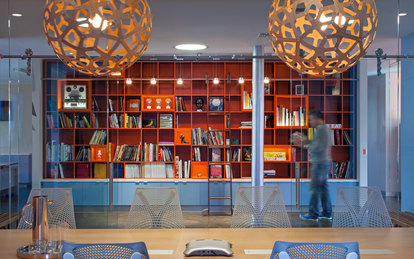CoreNet Global Hackathon: Distributed Work & the Workplace Following COVID-19

Following government-issued orders to shelter-in-place, organizations across industries shuttered offices and employees were directed to work from home – in some cases, indefinitely. With no cure for COVID-19 on the immediate horizon, we find ourselves in the middle of an unexpected and on-going worldwide experiment assessing the benefits and challenges of remote working. Many are wondering how this experiment will impact workplace strategies and corporations’ real estate holdings moving forward. Will organizations that were once reluctant to embrace remote work now see it as a viable option? Or will employees be eager to return to their physical workplaces to engage and collaborate with colleagues in person? Another question weighing heavily on minds: Which work modality—in-office or remote—will yield the greatest value to employers?
SmithGroup design principal Bob Varga came together with teammates to explore these issues and establish recommendations for the future of work. Taking into account the varied components that comprise the broad ecosystem of distributed work—these range from employers, employees, landlords and service providers to the nature of work, individual wellness, the economy and a company’s financial viability—the group’s recommendations centered on the premise that remote work (in some capacity) is here to stay. As the adoption of distributed work continues to rise, there will be substantial downstream effects beyond reductions in real estate holdings. While high vacancy rates, reduced construction activities and changes in lease lengths and lending rates are certainly anticipated, organizations should also prepare for the following:
- Office densities will not return to pre-COVID-19 levels.
- As much as 25-30% of the U.S. workforce will likely continue to work remotely multiple days/week through 2021 or beyond.
- Job functions that are not location-specific will be the first to change.
- As real estate needs continue to evolve, organizations may more frequently turn to flex space providers, driving increased competition for traditional landlords.
According to the group’s research, 50% of the U.S. job force (which was estimated at 164.6 million in February of 2020) holds a position that is compatible with at least partial telework. In addition, approximately 20-25% of the workforce was engaging in teleworking at some frequency even before the COVID-19 pandemic.
Hackathon participants recognized that not all organizations are ready to embrace remote work as a viable option—even though it may have proven feasible while stay-at-home mandates were in place. In some instances, this reluctance stems from the entity’s ability to easily (or not so easily) transition to a distributed work methodology for a variety of reasons. Nonetheless, with far-reaching economic impacts rippling across industries, organizations will be increasingly challenged to keep expenditures in check. And all enterprises will have to skillfully address employees’ mounting COVID-related concerns – including fear, health and well-being, feelings of isolation and disconnectedness, technology constraints, and a need for authentic relationships and meaningful social interaction. While all organizations will certainly weigh the financial and non-financial benefits surrounding when and how employees return to work, the focus group recommends that, at a minimum, all companies:
- Review and redefine their physical space needs
- Align newly established space needs with an employee-centric workplace strategy (which must be fully supported by leaders at all levels across the company)
- Listen to employees and build trust by conducting pre-and post-return to work surveys
- Maintain regular communications to keep employees informed
- Realign workplace and flexible work policies, as necessary
More detailed findings from this group’s discussions can be found in the following report and supporting presentation.